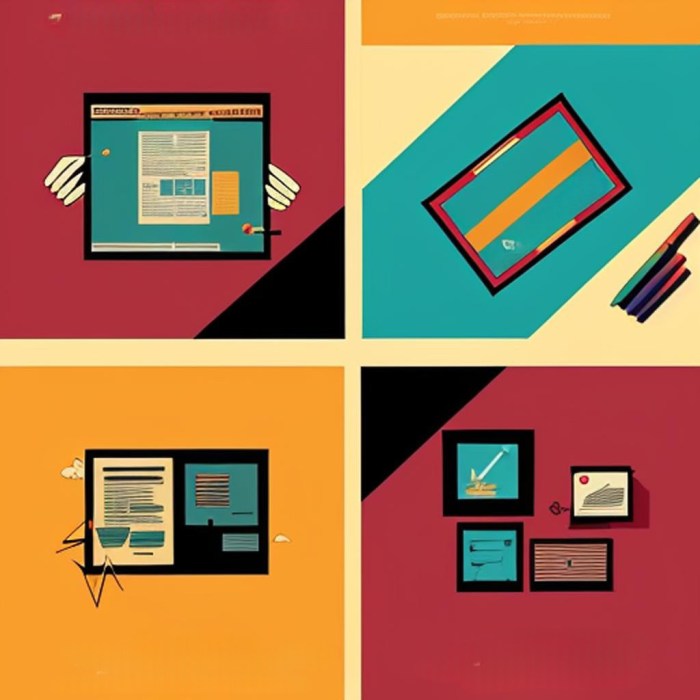Designing Visual Content sets the stage for creating captivating graphics that resonate in the digital landscape, blending creativity with strategic messaging to make a lasting impact. From the importance of visuals to the tools and techniques used, this journey explores the art and science of visual storytelling.
Overview of Designing Visual Content

Visual content plays a crucial role in digital media, capturing the audience’s attention and conveying messages effectively. By incorporating visual elements, brands can enhance communication, engage with their audience, and establish a strong brand identity.
Importance of Visual Content
Visual content is essential in digital marketing as it helps to grab the viewer’s attention quickly, increase brand recall, and drive engagement. From eye-catching graphics to compelling videos, visual elements have the power to make content more memorable and shareable.
Enhancing Communication with Visual Elements
Visual elements such as infographics, images, and videos can simplify complex information, making it easier for the audience to understand and retain. By using a combination of colors, typography, and imagery, brands can create a cohesive visual identity that resonates with their target audience.
Examples of Effective Visual Content
- Coca-Cola’s iconic red and white logo instantly conveys a sense of refreshment and happiness.
- Nike’s “Just Do It” campaign uses powerful imagery to inspire and motivate consumers to pursue their goals.
- Apple’s minimalist product design and sleek visuals communicate a sense of sophistication and innovation.
Role of Design Principles
Design principles such as balance, contrast, and emphasis play a crucial role in creating visually appealing content. By applying these principles, designers can ensure that their visual content is engaging, easy to navigate, and reinforces the brand’s messaging effectively.
Types of Visual Content
Visual content plays a crucial role in digital marketing, capturing the audience’s attention and conveying messages effectively. Different types of visual content are utilized to engage with viewers, including images, videos, infographics, and animations. Each type has its unique characteristics and impact on audience engagement.
Images
Images are static visual elements that can convey powerful messages in a single frame. They are widely used on social media platforms, websites, and online advertisements to attract attention and evoke emotions. High-quality images can enhance brand identity and storytelling, making them essential for visual content strategies.
Videos
Videos are dynamic visual assets that combine visuals, audio, and motion to deliver engaging content. They are highly versatile and can be used for product demonstrations, tutorials, storytelling, and promotional campaigns. Videos have the advantage of capturing the audience’s attention for longer periods, leading to higher engagement and shareability.
Infographics, Designing Visual Content
Infographics are visual representations of complex information or data presented in a clear and concise format. They are effective in breaking down information into digestible chunks, making it easier for viewers to understand and retain key messages. Infographics are commonly shared on social media platforms and websites to educate and inform audiences.
Animations
Animations are moving images created through a sequence of frames or computer-generated graphics. They are engaging and entertaining, making them ideal for storytelling and brand promotion. Animations can bring concepts to life, making them memorable and shareable among viewers. They are often used in digital ads, explainer videos, and social media content.
Examples of Successful Visual Content Campaigns
- Nike’s “Dream Crazy” campaign featuring Colin Kaepernick, combining powerful images and storytelling to evoke emotions and spark conversations.
- Tasty’s recipe videos on Facebook and Instagram, using engaging visuals and step-by-step instructions to attract food lovers and drive engagement.
- Spotify’s “Wrapped” campaign, utilizing personalized infographics to showcase users’ listening habits and create shareable content across social media platforms.
- Disney’s animated movie trailers, captivating audiences with visually stunning animations and enticing storylines to generate excitement and anticipation.
Design Principles for Visual Content
Color theory plays a crucial role in visual design as it helps evoke emotions, convey messages, and create visual hierarchy. Understanding the psychology behind colors can significantly impact the overall look and feel of a design.
Significance of Color Theory
- Color schemes like complementary, analogous, or monochromatic can be used to create harmony and contrast in visual content.
- Warm colors like red, orange, and yellow can evoke feelings of energy and excitement, while cool colors like blue, green, and purple can create a sense of calm and serenity.
- Using color psychology can help designers effectively communicate the intended message and engage the audience on a deeper level.
Role of Typography
- Typography is not just about choosing fonts but also about creating hierarchy, readability, and visual interest in the content.
- Pairing different font styles like serif and sans-serif can add contrast and emphasis to key elements in the design.
- Adjusting font size, spacing, and alignment can help improve the overall readability and visual appeal of the content.
Maintaining Visual Consistency
- Establishing a style guide with consistent colors, fonts, and design elements can help maintain visual consistency across different content pieces.
- Using templates or design systems can streamline the design process and ensure a cohesive look and feel across various platforms and mediums.
- Regularly reviewing and updating the style guide can help adapt to changing trends and keep the visual content fresh and relevant.
Whitespace and Balance in Design
- Whitespace, also known as negative space, is essential for creating breathing room and improving the overall clarity and focus of visual elements.
- A well-balanced composition with proper distribution of elements can help create a sense of harmony and visual stability in the design.
- Avoid overcrowding the design with too many elements and embrace whitespace to enhance the visual appeal and impact of the content.
Tools and Software for Designing Visual Content

When it comes to creating eye-catching visual content, having the right tools and software at your disposal can make all the difference. From graphic design software to online platforms, there are plenty of options to choose from. Let’s dive into some popular choices and tips for beginners.
Popular Design Tools
- Adobe Creative Suite: Adobe’s suite of design software, including Photoshop, Illustrator, and InDesign, is a powerhouse for creating stunning visual content. Each program offers unique features and capabilities for different design needs.
- Canva: Canva is a user-friendly online design platform that offers a wide range of templates, graphics, and tools to help you create professional-looking designs with ease.
- PicMonkey: PicMonkey is another online design platform that specializes in photo editing and graphic design. It’s known for its simplicity and intuitive interface, making it a great choice for beginners.
Adobe Creative Suite Overview
Adobe Creative Suite is a collection of industry-standard design software that allows users to create everything from logos and illustrations to marketing materials and websites. With a wide range of tools and features, Adobe Creative Suite is a go-to choice for professional designers.
Online Design Platforms Features
- Canva: Canva offers a drag-and-drop interface, thousands of templates, and a vast library of graphics and fonts to choose from. It’s perfect for creating social media posts, presentations, and more.
- PicMonkey: PicMonkey provides photo editing tools, graphic design features, and collage-making capabilities. It’s ideal for enhancing photos and creating custom graphics for various projects.
Tips for Beginners
- Consider your design needs: Think about the type of visual content you’ll be creating and choose tools that align with those needs.
- Start with user-friendly platforms: If you’re new to design, opt for tools like Canva or PicMonkey that offer intuitive interfaces and plenty of resources for beginners.
- Explore tutorials and resources: Take advantage of online tutorials and guides to learn how to use different design tools effectively and enhance your skills.
